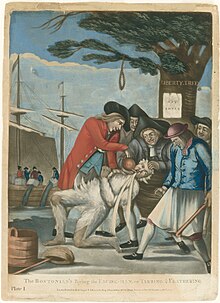Liberty Tree (Boston)
The Liberty Tree (1646–1775) was a famous elm tree that grew on the common land of Boston , Province of Massachusetts Bay , in the days leading up to the American Revolution . The tree was a meeting point for the growing opposition to England's rule over the American colonies . In the years that followed, almost every American city had its own tree of freedom - a living symbol of popular support for individual freedom and resistance to tyranny.
In 1765 the British government imposed a stamp law on the American colonies . It required that all legal documents, permits, trade contracts, newspapers, pamphlets and playing cards in the American colonies be tax stamped. The colonists viewed the law as a means of censorship or a "knowledge tax" on the colonists' rights to freely write and read.
The summer of 1765 in Boston was shaped by militant citizens who demonstrated against the stamp decree. On August 14, 1765, in Boston, a group of men who called themselves the Sons of Liberty gathered under a large elm tree on the corner of Essex Street and Orange Street, near Hanover Square, to protest the stamp enactment. The Sons of Liberty concluded their protest by symbolically hanging two tax collectors. From that day on, the tree became known as the "freedom tree". The tree was often decorated with banners and lanterns. A flagpole or pole was erected within the point of the tree and when a banner (usually a yellow one) was raised, the Sons of Liberty were to meet.
When the news of the Tree of Liberty spread to all colonies, rebels formed a group of Sons of Liberty in each of the 13 colonies and set a large tree as a meeting place. At that time, holding an unauthorized meeting was a dangerous undertaking as it could result in prison terms or death. The chance appearance of a group chatting under a tree was much safer.
Other cities also determined their own trees of freedom. The Liberty Tree in Acton, Massachusetts was an elm that lasted until about 1925. In 1915, when the elm was beginning to die, students planted the Peace Tree, a Norwegian maple that still stands today.
In the years leading up to the war, the British ridiculed the freedom tree. British soldiers tarred and feathered a man named Ditson and forced him to march in front of the tree. During the siege of Boston , around the last day of August 1775, a group of loyalists led by Job Williams felled the tree, knowing what it represented to the colonists, and used the tree as firewood. This act made the rebels even more angry. As opposition to the British grew, flags bearing an image of the tree of freedom were carried to symbolize the spirit of freedom. These flags were later a common sight during the fighting in the American War of Independence.
Commemoration of the freedom tree
For many years the remnant was used as a point of reference by local citizens, similar to the Boston Stone, and became known as the "Freedom Stump." Citizens later erected freedom stakes in many of the colonies in memory of the freedom tree.
In October 1966 the Boston Herald began publishing articles showing that the commemoration of the Liberty Tree's stand was a dirty slab on a three-story building where Washington Street and Bosylton Street now intersect. Reporter Ronald Kessler discovered that the slab, a block east of the Boston parks, was covered in bird droppings and smeared with a sign from Kemp's hamburger.
Nobody in the area had ever noticed the "America Was Born" site. City guides hadn't mentioned them.
"The freedom tree? It's a roast beef sandwich with a slice of Bermuda onion, Russian dressing and potato salad, ” replied a waitress who had worked under the plate in Essex Delicatessen for 20 years, Kessler, when he asked if she knew what the freedom tree was . The freedom tree was a specialty sandwich on the delicatessen menu.
Kessler then convinced Massachusetts Governor John A. Volpe to visit the place. A recording of Volpe examining the panel from a fire ladder appeared on page one of the October 6, 1966 issue of the Boston Herald.
Volpe promised to keep the place. Eventually, the Boston Redevelopment Authority created a beautiful bas-relief copy of the Tree of Liberty in bronze and placed it in a small plaza on Boylston Street near Washington Street. The plate bears the inscription “Sons of Liberty, 1766; Independence of the Country, 1776 ”(Sons of Liberty, 1766; Independence of the Country, 1776).
Web links
- Liberty Elms from the Elm Research Institute
- Information on Acton's Peace and Freedom Trees
- "Liberty Tree" , a poem by Thomas Paine in the English language Wikisource
Coordinates: 42 ° 21 '8.64 " N , 71 ° 3' 45.23" W.
